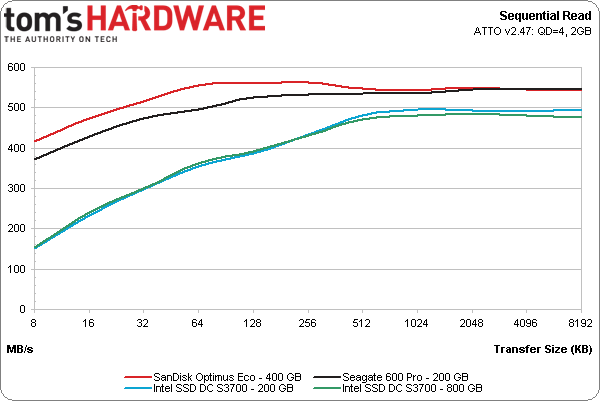SanDisk Optimus Eco SSD: A SAS Interface And Up To 2 TB Of Flash
Consolidation drastically changed the face of enterprise solid-state storage in 2013. One of the bigger moves was SanDisk's acquisition of SMART Storage Systems. Today, we're looking at the first branded SAS-based SSD to come from that purchase.
Results: Sequential Performance
If we could change Intel's SSD DC S3700 in one way, we'd fix its sequential performance. Considering the drive's exceptional showing across the rest of our suite, we never understood why sequential performance ended up being so average.
The Optimus Eco demonstrates no such shortcomings in our sequential read test. It starts off incredibly strong, maintaining a quantifiable lead over Seagate's 600 Pro. At the largest transfer sizes, both the Optimus Eco and 600 Pro top out in excess of 550 MB/s, basically saturating their 6 Gb/s interfaces. Intel's SSD DC S3700 needs those big transfers to even approach 500 MB/s.
Sequential writes aren't as kind to the Optimus Eco. The drive has a hard time getting steady on its feet, and we'd blame shallow queue depths and small transfer sizes for that. As the transfers grow beyond 64 KB, though, SanDisk speeds past the competition on its way to 550 MB/s yet again.
We actually see a lot of drives that claim to be capable of peaking above 500 MB/s in sequential tests, but few able to achieve such a lofty goal in a steady state. The Optimus Eco, however, was just as content writing more than 500 MB/s right out of its box as it was after hours of testing.
Get Tom's Hardware's best news and in-depth reviews, straight to your inbox.
Current page: Results: Sequential Performance
Prev Page Results: Enterprise Workload Performance Next Page Results: Enterprise Video Streaming Performance
